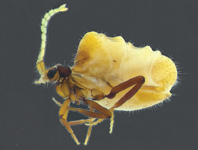Abstract
Species composition and distribution of ciliated protozoa obtained from the forestomach of 20 dromedary camels living in Zawiya, Libya were examined. Nineteen species and 10 morphotypes belonging to eight genera were identified. The mean number of ciliates was 54.2 ± 32.9 × 104 cells ml−1 in the forestomach contents, and the mean number of ciliate species per host was 6.5 ± 2.9. Entodinium and Epidinium were the main genera, as these ciliates were found consistently at higher proportions than those of the other genera. In contrast, Ophryoscolex and Polyplastron were only observed at low frequencies. Diplodinium rangiferi, Entodinium ellipsoideum, E. simulans, and Polyplastron multivesiculatum were new endosymbionts recorded from camels.
References
Baraka, T.A. (2012) Comparative studies of rumen pH, total protozoa count, generic and species composition of ciliates in camel, buffalo, cattle, sheep and goat in Egypt. Journal of American Science, 8 (2), 655–669.
Buisson, J. (1923) Sur quelques infusoires nouveaux ou peu cones parasites des mammifères. Annales de Parasitologie Humaine et Comparee, 1, 209–246.
https://doi.org/10.1051/parasite/1923013209Coleman, G.S. (1980) Rumen ciliate protozoa. Advances in Parasitology, 18, 121–173.
https://doi.org/10.1016/S0065-308X(08)60399-1Cucchi, M.C., Marcoppido, G., Dekker, A., Fondevila, M., De La Fuente, G., Morici, G. & Cravero, S. (2016) Ciliate protozoa of the forestomach of llamas (Lama glama) from locations at different altitude in Argentina. Zootaxa, 4067 (1), 49–56.
https://doi.org/10.11646/zootaxa.4067.1.3Dehority, B.A. (1974) Rumen ciliate fauna of Alaskan moose (Alces americana), musk-ox (Ovibos moschatus) and dall mountain sheep (Ovis dalli). Journal of Protozoology, 21, 26–32.
https://doi.org/10.1111/j.1550-7408.1974.tb03612.xDehority, B.A. (1984) Evaluation of subsampling and fixation procedures used for counting rumen protozoa. Applied and Environmental Microbiology, 48 (1), 182–185.
Dehority, B.A. (1986) Protozoa of the digestive tract of herbivorous mammals. Insect Science and Its Application, 7, 279–296.
https://doi.org/10.1017/S1742758400009346Dehority, B.A. & Odenyo, A.A. (2003) Influence of diet on the rumen protozoal fauna of indigenous African wild ruminants. Journal of Eukaryotic Microbiology, 50 (3), 220–223.
https://doi.org/10.1111/j.1550-7408.2003.tb00121.xDel Valle, I., De La Fuente, G. & Fondevila, M. (2008) Ciliate protozoa of the forestomach of llamas (Lama glama) and alpacas (Vicugna pacos) from the Bolivian Altiplano. Zootaxa, 1703, 62–68.
Dogiel, V.A. (1925) Neue parasitische infusorien aus dem magen des renntieres (Rangifer tarandus). Archiv of Russian Protistology, 4, 43–65.
Dogiel, V.A. (1927) Monographie der Familie Ophryoscolecidae. Archiv für Protistenkunde, 59, 1–288.
Dogiel, V.A. (1928) La faune d’infusoires habitant l’estomac du buffle et du dromadaire. Annales de Parasitologie Humaine et Comparee, 6, 323–338.
https://doi.org/10.1051/parasite/1928063323Ghali, M.B., Scott, P.T. & Al Jassim, R.A.M. (2005) Effect of diet change on population of rumen protozoa in dromedary camel. Recent Advances in Animal Nutrition in Australia, 15, 27A.
Gürelli, G. (2014a) Rumen ciliate fauna (Ciliophora, Protista) of Turkish domestic goats living in İzmir, Turkey. Turkish Journal of Zoology, 38, 136–143.
https://doi.org/10.3906/zoo-1303-21Gürelli, G. (2014b) First record of Diplodinium rangiferi Dogiel, 1925 (Ophryoscolecidae, Entodiniomorphida) from domestic cattle. Turkish Journal of Zoology, 38, 369–372.
https://doi.org/10.3906/zoo-1302-6Gürelli, G. (2016) Rumen ciliates of domestic cattle (Bos taurus taurus) in Kastamonu, Turkey, with the description of a new species. European Journal of Protistology, 56, 51–59.
https://doi.org/10.1016/j.ejop.2016.07.002Gürelli, G., Canbulat, S., Aldayarov, N. & Dehority, B.A. (2016) Rumen ciliate protozoa of domestic sheep (Ovis aries) and goat (Capra aegagrus hircus) in Kyrgyzstan. Fems Microbiology Letters, 363, 1–7.
https://doi.org/10.1093/femsle/fnw028Hungate, R.E. (1966) The Rumen and Its Microbes. Academic Press, New York, 533 pp.
Imai, S., Matsumoto, M., Watanabe, A. & Sato, H. (2002) Establishment of a spinated type of Diplodinium rangiferi by transfaunation of the rumen ciliates of Japanese sika deer (Cervus nippon centralis) to the rumen of two Japanese shorthorn calves (Bos taurus taurus). Journal of Eukaryotic Microbiology, 49 (1), 38–41.
https://doi.org/10.1111/j.1550-7408.2002.tb00337.xImai, S. & Rung, G. (1990) Ciliate protozoa in the forestomach of the Bactrian Camel in Inner Mongolia, China. The Japanese Journal of Veterinary Medical Science, 52 (5), 1069–1075.
https://doi.org/10.1292/jvms1939.52.1069Imai, S., Shinno, T., Ike, K., Morita, T. & Selim, H.M. (2004) Fourteen morphotypes of Entodinium ovumrajae (Ophryoscolecidae, Entodiniomorphida) found in the Dromedary camel of Egypt. Journal of Eukaryotic Microbiology, 51 (6), 594–597.
https://doi.org/10.1111/j.1550-7408.2004.tb00591.xImai, S., Tsutsumi, Y., Yumura, S. & Mulenga, A. (1992) Ciliate protozoa in the rumen of Kafue lechwe, Kobus leche kafuensis, in Zambia, with the description of four new species. Journal of Protozoology, 39 (5), 564–572.
https://doi.org/10.1111/j.1550-7408.1992.tb04852.xIqbal, A. & Khan, B.B. (2001) Feeding behaviour of camel. Pakistan Journal of Agricultural Sciences, 38, 58–63.
Ito, A., Imai, S. & Ogimoto, K. (1993) Rumen ciliates of ezo deer (Cervus nippon yesoensis) with the morphological comparison with those of cattle. The Journal of Veterinary Medical Science, 55 (1), 93–98.
https://doi.org/10.1292/jvms.55.93Kubesy, A.A. & Dehority, B. (2002) Forestomach ciliate protozoa in Egyptian dromedary camels (Camelus dromedaries). Zootaxa, 51, 1–12.
https://doi.org/10.11646/zootaxa.51.1.1Lubinsky, G. (1964) Ophryoscolecidae of a guanaco from the Winnipeg zoo. Canadian Journal of Zoology, 42 (1), 159.
https://doi.org/10.1139/z64-014Lynn, D.H. (2008) The Ciliated Protozoa, Characterization, Classification and Guide to the Literature. Springer, Dordrecht, 605 pp.
Mukasa-Mugerwa, E. (1981) The Camel (Camelus dromedarius): A Bibliographical Review. International Livestock Centre for Africa, Addis Ababa, 147 pp.
Ogimoto, K. & Imai, S. (1981) Atlas of Rumen Microbiology. Japan Scientific Societies Press, Tokyo, 231 pp.
Selim, H.M., Imai, S., Yamato, O., Kabbany, A.E., Kinoloss, F. & Maede, Y. (1996) Comparative study of rumen ciliates in buffalo, cattle and sheep in Egypt. The Journal of Veterinary Medical Science, 58, 799–801.
https://doi.org/10.1292/jvms.58.799Selim, H.M., Imai, S., El Sheik, A.K., Attia, H., Okamoto, E., Miyagawa, E. & Maede, Y. (1999) Rumen ciliate protozoal fauna of native sheep, friesian cattle and dromedary camel in Libya. The Journal of Veterinary Medical Science, 61, 303–305.
https://doi.org/10.1292/jvms.61.303
Van Soest, P.J. (1994) Nutritional Ecology of the Ruminant. Cornell University Press, New York, 476 pp.
Wertheim, P. (1937) La fauna des infusoires de I’estomac des ruminants domestiquès dans les jardins Zoologiques. Annals of Parasitology, 15, 248–252.
https://doi.org/10.1051/parasite/1937153248
Williams, A.G. & Coleman, G.S. (1992) The Rumen Protozoa. Springer, New York, 441 pp.
https://doi.org/10.1007/978-1-4612-2776-2
Wilson, R.T. (1989) The nutritional requirements of camel. Options Méditerranéennes, Série Séminaires, 2, 171–179.

